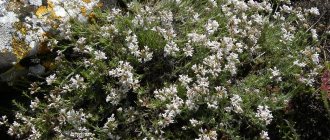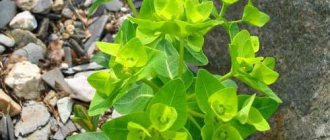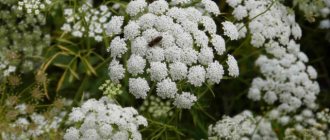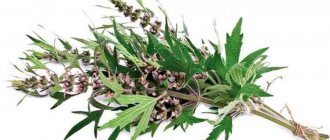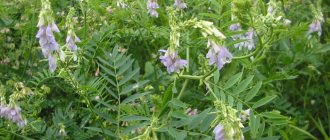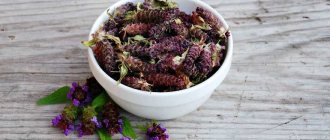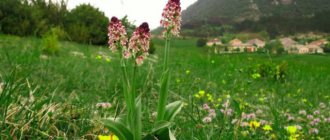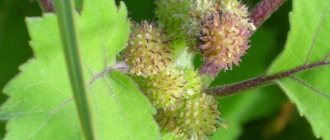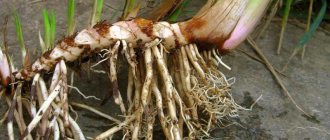Sweet nettle or dead nettle is a weed that owners of private plots mercilessly destroy, not even suspecting that this perennial is quite popular in folk medicine.
The herb has a number of medicinal properties, is often used in the treatment of serious diseases, and has considerable success among fans of home cosmetology. Often the aromatic plant is added to dishes, adding piquancy, creating a new pleasant note.
Before using weed, it is recommended to carefully study the basic characteristics, rules of use, and preparation of home remedies. Be sure to familiarize yourself with the contraindications - such precautions will help you avoid undesirable consequences.
Brief description, grass growth
Laminaria is a herbaceous perennial with low (up to 25 cm) creeping stems. The rhizome is large, powerful, and has many shoots. The grass is frost-resistant - small leaves bloom in early spring and remain green until frost. The leaves are petiolate, soft, covered with delicate hair.
Flowering lasts from late spring to autumn. The flowers are inconspicuous - small, with thin stamens. Pollination ends with the formation of a fruit. The seed pods open on their own, resulting in self-seeding. Fruiting begins in mid-summer and continues until winter.
The most common grass in Eastern Europe. The plant occupies the banks of reservoirs, often settles in vacant lots, near fences, and densely covers forest clearings.
Appearance and places of growth of white jasmine
The perennial creeping grass belongs to the Lamiaceae family. The root system, which has numerous roots, is located on the soil surface. The erect stem can reach more than half a meter. The top is covered with light hairs, and in cross-section it has the shape of a tetrahedron.
Despite the similarity in appearance with nettles, white nettle does not burn when you touch leaves that have a more interesting color. They measure about 12 cm long and 6 cm wide, and are ovoid in shape with a heart-shaped notch at the base. Flowering continues for a fairly long period, from mid-spring to late autumn. The flowers, emitting the scent of honey, with a soft white tubular corolla, slightly more than 1 cm in length, are arranged in inflorescences and located in the upper axils of the stems. Then a yellowish-gray fruit appears in the form of a nut with white pimply spots.
This representative of the flora is native to areas with a temperate climate (countries of North Africa, Europe, Asia). Yamna grows both in the wild (deciduous and coniferous forests, mountains, coastal slopes) and near human habitation. Prefers semi-shaded, moist places with fertile soil. Propagates by self-sowing. It easily tolerates drought because it has the ability to recover quickly. The plant can be collected in Russia (west and east of Siberia, the Caucasus), in the territory of Moldova, Belarus and Ukraine.
White yasnotka belongs to the family Yasnotaceae
Collection, secrets of drying, storage
Young leaves and flowers of the herb are used for treatment. You should go for valuable raw materials, rich in vitamins, minerals, and essential oils in the summer. Cut young shoots and flowers with sharp scissors or pruning shears and place them in a basket.
Rinse houses (especially if the collection was carried out in polluted areas, near noisy roads), and allow the water to drain. Dry the plant material a little and place it on wide baking sheets or wire racks. It is recommended to cover the containers with cardboard and gauze, and only then lay out leaves and flowers.
Carry out drying under canopies, be sure to provide good ventilation. It’s easy to speed up the drying process - stir the plant material periodically.
After drying, place the finished valuable component into glass jars and plastic containers. If there is a room with low humidity, you can pack it in canvas bags.
Article for you:
Beneficial and medicinal properties of muraya and its use in folk medicine
During storage, periodically check the condition of the grass. Carefully sort through the plant materials, if the particles of leaves and flowers are damp, dry again (you can use the oven, the optimal temperature is 35-40 degrees).
The plant is not recognized by official medicine, so you should not look for a valuable component for preparing decoctions in the pharmacy. The only way to stock up on weed is to go out into nature on your own.
Treatment of hemorrhoids
Traditional medicine recommends treating hemorrhoids using a saturated decoction. The plant has anti-inflammatory and analgesic properties. The only requirement is to first consult a doctor.
It is possible to cope with the disease with traditional treatment only in the first stages of development. In advanced forms, you will have to use a homemade herbal medicine as an adjuvant to complement drug therapy. Step-by-step folk recipe:
- Place vegetable raw materials (15 g) in a cooking container.
- Steam with boiled water (200 ml), stir.
- Place the container in a steam bath and soak the mixture for a quarter of an hour (you can replace simmering in a steam bath with cooking in a thermos - it will take half an hour to infuse).
- Wait until cool, strain.
Take 20 ml of the product throughout the day. Maintain equal time intervals – 2-3 hours. It is forbidden to exceed the dosage - this will not affect the effectiveness.
Treatment is usually carried out in courses - after two weeks of using the decoction, take a break (5-7 days). It usually takes 2-3 courses to get rid of hemorrhoids.
Yasnotka for contraction of the uterus, with bleeding
In alternative medicine, white cherry is considered a female herb - the plant effectively copes with intense bleeding during menstruation.
The herb is also used when the uterus expands after the birth of a baby - the active components effectively narrow it and trigger the regeneration of tissues damaged during childbirth. A concentrated infusion is the most effective home remedy, also for discomfort during menstrual periods.
The herb relieves painful sensations, nagging pain in the lower abdomen, and alleviates the general condition. Preparation:
- Turn fresh leaves and flowers of the plant (25 grams) into a fine pulp.
- Place water on the stove, and after bubbles appear on the surface of the liquid, brew the herbal mixture (you will need 250 ml of liquid).
- Leave the composition to brew, strain after half an hour.
Article for you:
Lichen beardedum: beneficial properties and contraindications, use in folk medicine and cosmetology
Drink the prepared healing liquid in two doses. One - in the morning, the second - an hour before going to bed. It is not recommended to use the product just before going to bed - it has a slight diuretic effect.
Classification
Taxonomic position
The genus Lamiaceae, like more than fifty genera, belongs to the subfamily Lamioideae
) family
Lamiaceae
:
| department Flowering , or Angiosperms | ||||||||||||||||||||
| order Lamiaceae | another 58 orders of flowering plants (according to the APG III Classification System, 2009), of which the Harriaceae, Gentianaceae and Solanaceae are the closest to the Lactaceae | |||||||||||||||||||
| family Lamiaceae | 22 more families (APG III), including Acanthaceae, Bignoniaceae, Verbenaaceae, Gesneriaceae, Broomaceae, Oliveaceae, Norichaceae, Pedalaceae, Plantainaceae | |||||||||||||||||||
| subfamily Lamiaceae | eight more subfamilies, including Catnipaceae (genera Basil, Lavender, Melissa, Mint, Rosemary, Chernogolovka, Sage, etc.), Tenacious (Zhivuchka, etc.), Pogostemonaceae (Pogostemon, etc.) | |||||||||||||||||||
| genus Yasnotka | more than 50 more genera, including Belokudrennik, Zaytsegub, Censer, Pikulnik, Motherwort, Chistets, Shandra | |||||||||||||||||||
| about 30 species[3], including White Laminaria, Green Lamy, Speckled Lamy, Purple Lamy | ||||||||||||||||||||
Kinds
The Plant List database
(2013), the genus includes 25 species[3]:
- Lamium album - White nettle or dead nettle
- Lamium amplexicaule
- Lamium bifidum Cirillo
- Lamium caucasicum Grossh. — Caucasian yasnotka
- Lamium confertum Fr.
- Lamium coutinhoi JGGarcía
- Lamium eriocephalum Benth.
- Lamium flexuosum Ten.
- Lamium galactophyllum Boiss. & Reut.
- Lamium galeobdolon ()
- Lamium garganicum
- Lamium gevorense (Gómez Hern.) Gómez Hern. & A.Pujadas
- Lamium glaberrimum (K.Koch) Taliev
- Lamium × holsaticum Prahl
- Lamium macrodon Boiss. & A. Huet
- Lamium maculatum () - Speckled lily, or Spotted lily
- Lamium moschatum Mill.
- Lamium multifidum
- Lamium orientale (Fisch. & CAMey.) EHLKrause
- Lamium orvala
- Lamium purpureum typus[4]
- Lamium taiwanense SSYing
- Lamium tomentosum Willd.
- Lamium tschorochense APKhokhr.
- Lamium vreemanii APKhokhr.
Five more species names of this genus are in The Plant List
unresolved name
status , that is, there are doubts whether these described species should be considered independent or their names should be reduced to synonymy of other species [3].
Allergy treatment
Claryweed is an herb often used at home for allergic reactions. The plant relieves irritation, soothes, and copes with skin rashes.
It is recommended to use the herbal infusion internally and externally. It is allowed to use the product even during pregnancy - white yasmotka does not contain elements dangerous to the expectant mother or baby.
It is recommended to combine the herb with chamomile flowers, which can increase the effectiveness of the home remedy. Step by step recipe:
- Mix jasmine and chamomile (15 g each).
- Steam with boiling water (300 ml).
- Leave, tightly closing the container with a lid, for an hour.
- Strain, pour into a clean bottle, and place in the refrigerator.
Take 25-30 ml every three hours. Before each use, it is recommended to warm the liquid slightly - the active components will act more effectively. Treatment should not exceed three days.
If allergy symptoms do not disappear, immediately stop using the home remedy and seek medical advice. After examination and research, the doctor will determine the allergen - after it is eliminated, traditional treatment will be more effective.
Using nettle tincture - video recipes
You may also be interested: Kirkazon - benefits, properties, application
Skin – good for skin diseases. With the help of dead nettle herb, urticaria, eczema, diathesis and other skin diseases that are difficult to treat are treated.
Powder from ground, dried flowers is an effective remedy for scrofula, injuries, burns and bruises. Fresh juice from the inflorescences is taken orally and used for skin rashes and boils. In herbal collections for the treatment of dermatitis and psoriasis, dead nettle is often found.
Lamia flower photo
Yamna herb - folk recipes
Infusion of flowers
1 tbsp, 200 ml boiling water. Cover the infusion with a lid and leave until completely cooled. Drink 100 ml half an hour after meals.
Tincture of flowers
10 g of dried or fresh flowers are poured with a full glass of alcohol (40%), kept at room temperature for 7 days, strained, and stored in a cold place. Take thirty drops in half a glass of cold, boiled water.
Clary tea
Add the same amount of yarrow to a teaspoon of herbs, 200 ml of boiling water, and heat over low heat for 5 minutes. Drink a glass three times a day.
Bath
The twenty-minute procedure is carried out daily for a week. A tablespoon of dry herb is brewed with a glass of boiling water, allowed to stand for half an hour, then poured into the bath. Baths with dead nettle are excellent for skin diseases.
Recipes for women
Mix 20g of St. John's wort herb and dead nettle herb, steam with a glass of boiled water, keep on low heat for a quarter of an hour, leave for another hour after removing from the heat, strain. Used for douching in the evening. An infusion of the herb without additives is taken three days before the start of menstruation if there is pain. The drink is useful for anemia or frequent headaches.
Diathesis
3 tablespoons The mashed herb is brewed with boiling water (500 ml), after two hours it is decanted. Take a teaspoon four times a day if the child is over three years old. A more concentrated infusion is used to treat the skin.
Baths for hemorrhoids
A tablespoon, half a glass of boiling water. After 30 minutes add to the bath. Take a sitz bath for five minutes daily.
Kidney diseases
A spoonful of herbs, 250 ml of boiling water. The herbal infusion is filtered after two hours. Drink half a glass twenty minutes before meals.
Recovery after a stroke
3 tbsp. per liter of boiling water. The folk remedy is kept on low heat for ten minutes and left to infuse overnight. Take 100 ml before meals three times a day.
Use in home cosmetology – hair rinse
Laminaria is often used in home cosmetology. Typically, the herb is supplemented with other herbal components that enhance the effects of the main ingredient.
A rinse made from the plant promotes hair growth, saturates it with useful elements, and stops hair loss. Regular procedures improve the external condition of the strands - improve the shade, restore a healthy appearance. Preparation:
- Mix jasmine (15 grams), chamomile, horsetail, calendula (10 grams each).
- Finely chop the vegetable mass.
- Steam the herbal mixture with boiling water (500 ml).
- Cover the container and leave for half an hour.
Wash your hair thoroughly using natural shampoo and rinse with clean warm water. Complete the procedure by rinsing the strands with the prepared product.
Article for you:
Medicinal properties of motherwort herb and its use in folk medicine
If you have time, it is recommended to massage your hair a little with your fingertips. Massage promotes the penetration of beneficial substances into the epidermal tissue and activates the work of hair follicles.
In case of intense hair loss, it is recommended to prepare a strengthening mask using a rinse aid. Mix the herbal decoction, kefir, bee honey (take in equal quantities), a few drops of ether.
After mixing, apply the product along the entire length of the strand (pre-moisten), leave for 20 minutes. Rinse hair thoroughly. Repeat every 3 days.
